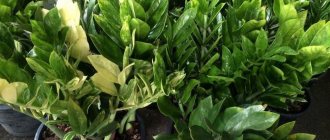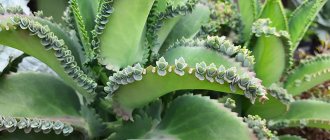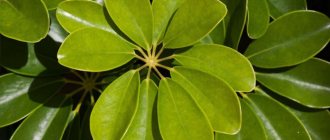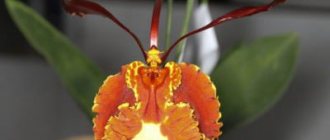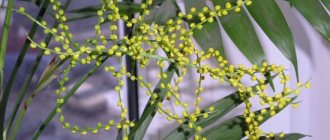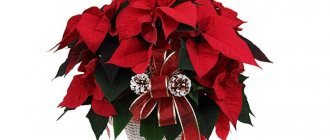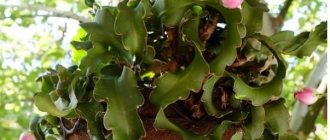- July 29, 2019
- Houseplants
- Natalia Miroshnikova
The Zamioculcas flower, also called the “dollar tree,” is popular among gardeners. This plant has an unpretentious nature; even a beginner can grow it if desired. In addition, according to signs, the flower brings good luck to the owners, and looks so attractive that it will decorate any interior. You will learn how to care for zamioculcas from our material.
Description
Zamioculcas, or dollar tree, belongs to the large family Araceae, and in its natural environment it can be found in the tropical mountainous regions of Africa and Madagascar. This plant is a herbaceous perennial with a tuberous rhizome and thick, fleshy roots, thanks to which it stores moisture.
Zamioculcas shoots reach up to 150 cm in height. They are densely covered with leathery, glossy, opposite, oval-shaped leaves with pointed tips. The plates are painted a rich dark green color, and perhaps that is why the plant received the second name “dollar tree”.
This succulent does not grow quickly, and it only adds a few leaves per year. But with proper care at home, the zamioculcas flower lives up to 10 years. And if you provide it with comfortable conditions, it can delight you with flowering and produce a small ear of pale cream color.
Bloom
It is rare that a gardener manages to see the flowers of this ornamental plant. But this does not mean poor flower care, since the appearance of flowers in Zamioculcas, even in its homeland, is a rare occurrence.
The inflorescences have an unusual spadix appearance, in which the male and female flowers are located on opposite sides and are separated by a row of sterile flowers. Inflorescences appear in the lower part of the plant, at a distance of 20 centimeters from the ground. This arrangement does not allow self-pollination. Pollination is carried out by small insects and the wind.
In place of faded flowers, small berries filled with seeds appear. It is impossible to get a ripe fruit at home. Experienced plant growers claim that the period of appearance of the first flowers largely depends on the location of the plant. So, if you place it on a “northern” windowsill, flowers will appear towards the end of the dollar tree’s life. Choosing a “southern” window promotes earlier flowering.
Varieties
The following types of zamioculcas are grown at home:
- Zamioculcas zamifolia. The variety is valued for its compact size. And the height of a tree of this type does not exceed 60 cm.
- Variegated Zamioculcas. A species distinguished by bright green leaves with pointed tips, which are located strictly symmetrically on the stems. There are also white spots and stripes on the plates. The plant reaches up to 1.5 meters in height.
- Zamioculcas lanceolate. The variety got its name for its elongated leaves of an unusual shape. The plant reaches up to 1.5 meters in height, but there are also more compact varieties with shoots whose length does not exceed 60 cm.
- Black Zamioculcas. The variety is valued for its unusual color of leaves and cuttings. Initially they are green, but as the plants grow they darken and become almost black.
Each of these varieties will become an interior decoration. But for this you will have to make some efforts and create comfortable conditions for the plants.
Review of popular varieties: description and photo
The line of modern succulent varieties and hybrids is represented by Dutch cultivars. Most of them are new products registered in the last decade.
Lucky white
The most widespread Dutch variety, registered in 2011 . Sometimes found under the name Lakivit (“Luckywhit”). It is represented by plants of small height (30-40 cm) and a compact crown shape. The petioles at the base are thick and light green. The leaves have a slightly wavy edge. The leaf blade covers 2/3 of its surface with streaks and spots of yellowish-green color.
Other variegated varieties are found only among true connoisseurs of Zamioculcas: in greenhouses of botanical gardens and private amateur collections.
Short leaf
The color of the petioles varies from light green to white-green. There are no individual color spots on them. The leaf is wide, ovoid, with white streaks and spots, up to 13 cm in length. Individual leaves may be completely white .
Lemon variegata
This is a variety of Short Leaf variety with lemon variegation (short leaf var. lemon). The leaves are elongated, lanceolate, thinner than those of the common zamioculcas, with lemon-yellow spots over the entire surface of the leaves.
Big leaf
Don't be intimidated by the appearance of the succulent! This yellow color of the foliage is due to varietal characteristics, and not to plant disease . The bush is large, up to 1-1.2 m tall. The petioles and young leaves have a rich yellow color, which turns slightly green with age.
Long leaf
It is distinguished by more elongated leaves with a pointed tip. The petioles are elongated and thin, green, with dark brown spots. The thickening at the base of the stem is not very pronounced. It has the largest leaves - up to 18 cm long and 9 cm wide. Along the edge of the leaf there are very pronounced cream spots, often merging into a single tone. The center of the leaf blade is covered with small creamy-white speckled spots. The leaves are all different, on one there is a strong variegation, on the other - not.
Reference! In addition to variegated hybrids, zamioculcas black (Raven) and purple (Black Leaf) have interesting foliage colors.
How to care for Zamioculcas
The dollar tree is an unpretentious plant; caring for it will not take much time and effort. In order for the plant to take root and please with its decorative appearance, it is enough to carry out the following agrotechnical measures:
- watering;
- feeding;
- transfer;
- prevention of diseases and pests.
And it is also important to maintain humidity, temperature and lighting that suit the zamioculcas plant. How to care for the plant is described in detail below.
Important! Zamioculcas is a poisonous crop, so all agricultural activities should be carried out with gloves. This is especially true for transplantation and reproduction. In addition, it is advisable to keep the flower away from children and pets.
Diseases and pests of Zamioculcas
vosaduly.ru
Zamioculcas is a very hardy plant, so diseases and pests rarely affect it. Most often, the cause of the problem is incorrect agricultural practices (for example, if you watered the plant too often) or unfavorable external factors (if the dollar tree spent the whole summer in the garden and became infected with pests from other crops).
If you notice changes in the appearance of the flower in time, it can still be saved. Try to regularly inspect the leaves of Zamioculcas, they will tell you if something went wrong. The most common problem is yellowing of dollar tree leaves. We have collected the reasons and ways to solve it in one table.
| Why do Zamioculcas leaves turn yellow? | What to do |
| Overmoistening of the soil (leaves turn yellow and then brown, roots soften) | Urgently replant the plant in fresh soil. First remove all rotten parts and treat the cuts with crushed coal or a weak solution of potassium permanganate |
| Overhumidification of the air | Stop spraying, regularly ventilate the room or move the flower to another room |
| Temperature changes (root shoots also rot and dry out) | Treat with Kornevin. If the room temperature is low, protect the plant from drafts; if the room temperature is high, place a container of water next to the pot. |
| Lack of fertilizing | Gradually introduce fertilizing with ready-made preparations, for example, Agricola fertilizer. Just do not exceed the dosage, otherwise the condition of the weakened plant may worsen |
| No trimming | Trim overgrown side shoots and remove yellow leaves. Transplanting the plant into a larger pot and regular feeding will also help. |
The lower leaves of an adult zamioculcas turn yellow and die over time. This is a natural aging process, so there is no need to worry.
One of the reasons for yellowing leaves may be the presence of pests: aphids, spider mites, mealybugs or scale insects.
If you find pests on Zamioculcas, immediately isolate it from other indoor plants to avoid a massive epidemic.
When growing zamioculcas, you may encounter other problems. For example, spots on the leaves indicate that the plant was overcooled in a draft or received sunburn. It is enough to remove aggressive environmental factors, and Zamioculcas will feel better.
If the stem begins to rot, the plant is overwatered and its tubers are most likely very badly damaged. In this case, you will have to throw it away, but you can still try to root the living leaves from the top and grow a new zamioculcas.
If the zamioculcas has lost its aerial part, do not rush to throw it away. Inspect the tuber, and if it looks good, soak it in a weak solution of potassium permanganate and plant it in fresh soil. The plant will probably survive and send out new shoots. The main thing is not to water it too often and protect it from drafts.
Lighting
Indoor zamioculcas is a light-loving flower. Therefore, you can place the plant near a south window. True, if you just bought a flower, then gradually accustom it to direct sunlight, otherwise brown spots will form on the leaves. In addition, do not forget to shade the plant during the midday hours.
And also an eastern or western window sill is suitable for growing zamioculcas. But on the north side the flower will suffer from lack of light. And here its growth will slow down greatly. Therefore, if you want to grow a beautiful shrub on the north side, then provide the plant with additional illumination with a phytolamp. Moreover, keep in mind that zamioculcas needs 12 hours of daylight.
Description of the variety - photo
Zamioculcas Zenzi (Zamioculcas zamiifolia) - belongs to the aroid family. This unpretentious evergreen plant in most of its characteristics is closest to succulents.
The flower is perfect for interior decoration because it has a pronounced external decorative effect. The plant looks so perfect that it feels like it is artificial. An amazing plant that hides its trunk in the soil. For the first time weeks after growth, the flower does not form roots. Instead, there is a tuber that stores large reserves of water. The tuber is somewhat reminiscent of a dark marsh or brown potato. Has the shape of an ellipse.
- Zamioculcas Zenzi has a thicker trunk.
- The leaves are dense and glossy.
- The color is rich dark green, sometimes almost black.
Since Zenzi is a dwarf form of Zamioculcas, it will not grow more than 60-75 cm. In addition, the shoots themselves are thicker and the leaves sit very tightly and seem to curl downward. We can say that Zenzi is a curly zamioculcas .
The closest “relatives” of the plant are Monstera and Dieffenbachia.
Its distinctive feature is its straight-growing glossy leaves, attached to the stem by long cuttings. Looking at the pot with the plant, it seems that bright green leaves are growing directly from the soil.
The leaves are attached to the tuber using a long stalk, which unknowing gardeners mistake for the trunk. The leaves grow from a tuber and are divided into 8-12 individual leaflets. This is very rare for this species. The feather is dense, glossy and has a thick, juicy axis in which the flower stores moisture.
The Zenzi variety is very decorative. Features:
- squat leaves (maximum length 60 cm);
- thickened petioles;
- leaves are oval, closely planted;
- The color is rich dark green, with a bright shine.
Important! The flower has poisonous sap, but it does not emit any toxic fumes. Therefore, keeping it at home is completely safe.
Bloom
Zamioculcas Zenzi blooms with inflorescences; they consist of a spadix and a spathe, which appear at the very base of the leaves. The spadix is an inflorescence consisting of small flowers of light shades: milky, light cream or yellowish, which smell quite pleasant.
The flowers are heterosexual and are found in inflorescences separately from each other. Women's - from below, men's - from above. Between them there are sterile flowers, they create a zone of sterility. Its role is to prevent plants from self-pollinating.
When and how does it bloom?
The flowering period occurs in spring . First, a small peduncle is thrown out, and a light leaf appears from it, covering the inflorescence. The Zenzi flower itself is inconspicuous.
The blanket has the same color as the rest of the leaf blades. For this reason, the inflorescence is difficult to see. The cob is first directed upwards, a little later, as it ripens, the cob begins to lean toward the ground.
Temperature
Homemade zamioculcas is a heat-loving flower. And from spring to autumn, it is advisable to maintain the temperature in the room with the plant within +22...+25 degrees. Cooler conditions are allowed in winter. But it is worth remembering that the mark of +16 degrees is critical for the culture.
At any time of the year, it is also important to provide the zamioculcas with an influx of fresh air. Therefore, ventilate the room regularly, and in the summer you can even send the flower to the balcony or garden. But remember that the plant does not tolerate drafts well. Therefore, during ventilation, take the pot to another room. And when growing on a balcony or in the garden, choose closed places for zamioculcas, where there are no sharp gusts of wind.
Planting and care
The plant does not require careful constant attention. Growing a healthy dollar tree is not difficult. In its natural habitat, the flower is accustomed to difficult growing conditions. Therefore, he is not at all capricious in his care.
How to plant in a pot:
- Place drainage made of expanded clay or small pebbles at the bottom of the new pot so that it occupies a quarter of the container.
- Add soil mixture.
- Place the tubers in the center of the pot.
- Add mixture.
- Do not water.
- Make the first watering after 5-7 days.
Pot for Zamiculcas
The dollar tree has one peculiarity: its root is so powerful that the plastic may not withstand it and will crack. This is a positive point in choosing a container, since the owner of the flower cannot always determine when to replant the zamioculcas. A bursting pot is a signal.
Clay is a stronger material, but if the roots become crowded, the plant will stop developing and stop growing.
Choose a tall pot, 3-5 cm larger than the tuber. In such a pot there will be room for both the stem and the roots.
- Young plants are planted in clay pots, they are replanted every year, and there is no danger of damaging the stem.
- Adult plants are transplanted as the underground part grows, which, as it develops, can fill the entire pot and even deform its walls. It is convenient to plant adult Zenzi in flexible pots, which can be cut painlessly for the plant and remove the tuber without damaging it. For beauty, such pots can be placed in flowerpots.
Watering
The health of the currency tree depends on proper watering. The plant is able to accumulate liquid, so it tolerates drought more easily than excess moisture. Excess moisture causes tubers to rot. Lack of moisture can be seen in the thinning of the leaves and their limp appearance. During prolonged drought, the flower may shed its leaves, especially during periods of intensive growth.
The following watering scheme should be followed:
- Spring and summer are the period of plant growth. Therefore, the flower needs extra moisture. Watering is carried out 3-4 times a month;
- Winter and autumn refer to the dormant period when the plant rests. It is necessary to reduce the frequency of watering to 1-2 times a month.
Settled water at room temperature is suitable for irrigation. Before moistening the soil, make sure the soil is completely dry. If excess water leaks into the pan, it must be drained immediately. When it stagnates, putrefactive processes begin.
Lighting
This is a light-loving plant. Although it brings great darkness. The best location is the window sill of a south window. You should not expose the flower to direct sunlight, as the leaves can get severely burned. It is worth hanging a small curtain on the window to create a slight oppression, especially in the summer season.
Without good lighting, the leaves of the dollar tree become thinner. They become slightly sluggish, and the bush loses all its decorative charm.
It is especially important to create bright lighting during the period of increased plant growth: spring and summer. In order for the growth to be uniform, you need to turn the flower towards the window with different sides, otherwise the symmetrical shape of the leaves will be absent.
The plant loves fresh air. Therefore, during the warm season it should be taken out into the garden or onto the balcony. It is first necessary to provide the eternal tree with slight shading and protection from precipitation.
Temperature
The plant comes from Africa, so it loves warmth very much. Intense heat exceeding thirty degrees will not cause any harm to the bush. Experts involved in breeding zamioculcas believe that the optimum temperature for normal growth and development of the plant is from 22 to 26 ºС.
A drop in temperature in winter to 16 ºС will not harm the bush at all. It should be noted that if the air temperature drops below 12 ºС, the plant may die. Sudden changes in temperature are also harmful to it.
Humidity
The flower tolerates dry air well. Spraying the plant with water is not an urgent need. It should be carried out when dust has accumulated on the leaves, which will be much more convenient to remove.
Only warm water is sprayed. Then the leaves are gently wiped with a damp soft cloth. Most often such “cleaning” should be carried out in the summer.
The soil
The soil for the plant should be loose and light, capable of allowing moisture and air to pass through well. Flower shops sell special formulations specifically for succulents.
You can prepare the soil yourself. You will need the following components:
- Turf land;
- Leaf soil;
- Peat;
- Sand.
All components are taken in equal proportions and mixed thoroughly. Flower growers advise adding a little sphagnum moss to this composition. The Zanzibar pearl does not like acidic soil, so the acidity of the soil should be neutral.
Before use, the soil must be disinfected. To do this, it is heated in a water bath for 10-15 minutes. You can also spill the soil with special chemical compounds or a weak solution of manganese. Some plant growers spill boiling water on the soil.
Add stones for looseness, and activated carbon to protect against fungus.
The soil for Zamioculcas should allow water to pass freely so that it does not linger inside. Soil with a large amount of humus leads to rotting of the roots, as it retains liquid well.
Top dressing
Experienced gardeners suggest how to care for a dollar tree indoor plant in terms of fertilizing: nutrient mixtures for cacti are best suited, but some do not refuse conventional mineral fertilizers with microelements for deciduous crops.
In order not to overfeed the plant, you must follow the rule for feeding succulents: water, then wait 3 days until the plant gets drunk. Only then apply fertilizer in liquid form, maybe a half dose.
In winter, nutrition is stopped, since the flow of sap in the tissues freezes and nutrients are not absorbed. They can cause the tuber to rot and the plant will die.
Transfer
Zamioculcas is a slow growing plant. Therefore, he will not need frequent transplants. A young flower is replanted once every two years. For a fully formed adult shrub, replanting once every five years is sufficient.
Zamioculcas should be replanted at home in the following cases:
- After purchasing a plant in a store. It is important where it came from and what kind of soil is in the container. If there are Russian nurseries, then they put peat in which the plant can quietly exist during the adaptation period - 2 - 3 months. Foreign producers grow crops in coconut fiber - it is impossible to keep the plant in it for a long time.
- The tuber has outgrown the pot - it can be seen above the surface of the soil and below in the holes for water outflow.
- With improper care, when the tubers began to rot and the leaves turned yellow. It is necessary to remove the plant from the soil, wash it with potassium permanganate, sprinkle all damage with chiseled activated carbon or treat it with a fungicide, and air dry it for a day. Next, prepare new soil and transfer zamioculcas.
- Planned transplantation of young specimens is carried out once every 2 years. It is enough for adults to pass after five years.
It is difficult to replant large plants, so they simply replace the top layer of soil with a new one.
Trimming
Old branches and branches with yellow leaves that have lost their beauty should be removed regularly. Since the plant is dwarf, there is no need to pinch the growth point; the leaves will reach 60-75 cm and stop growing. But you can carry out formative pruning - remove improperly growing shoots.
Humidity
Zamioculcas easily tolerates the dry air of an apartment, and does not need spraying. However, it is advisable to wipe the leaves of the flower with a damp cloth once a week. Otherwise, dust will accumulate on them. And this will have a bad effect not only on the decorative appearance of the plant, but will also worsen its health, because dust will block the access of fresh air to the leaves.
In addition, it is recommended to give the succulent a warm shower once a month. To do this, take the flower to the bath, cover the soil with polyethylene and wash the leaves and stems under low pressure of water. Then wait for the excess liquid to drain, and only then return the pot to its usual place.
How to water Zamioculcas
Water zamioculcas sparingly. The main rule: it is better not to top up than to overfill. From spring to autumn, make sure that water does not stagnate in the pan. In winter, water the plant as the soil dries to avoid rotting of the tuber and roots. Water only with warm, settled water, because... Zamioculcas does not like cold or even cool temperatures.
Despite the fact that zamioculcus stores water, you should not overdry it, otherwise the plant will shed its tops and lose its decorative appearance. Prolonged dryness can also cause spider mite infestation.
Wipe off dust on the leaves with a cloth as needed or give the zamioculcas a warm shower once a month.
As for spraying, it can only be carried out at very high air temperatures. The rest of the time, it is not advisable to do this, so as not to provoke yellowing of the leaves. To increase humidity, it is better to spray the air around the flower or place a container of water next to it.
Watering
The dollar tree is a succulent, which means that this plant tolerates drought more easily than over-watering. But it is not recommended to allow the soil to dry out completely, because even in this case the flower may die. Therefore, you need to approach watering with extreme caution.
Moisten the flower rarely but generously. Between waterings, the soil in the pot should dry out by half its volume. After irrigation, be sure to drain excess liquid from the pan. As a guide, you need to moisten the soil 1-2 times every two weeks in summer; in winter, when the flower enters a dormant period, it is advisable to carry out this procedure once a month.
At any time of the year, to water Zamioculcas, use only soft and settled water at room temperature.
How to trim zamioculcas
flowers.bitrix.ru
Despite its slow growth, zamioculcas requires regular crown formation and thinning. Otherwise, some of the leaves will not receive enough light and will turn yellow. Bare branches will not add decorative value to the flower. And if you prune regularly, you will get a luxurious green decoration for your interior.
Carry out pruning in spring or summer, but not in winter, when the tree has a dormant period. Dry and diseased parts of the plant, thickening stems and individual leaves must be removed. When replanting, also trim off some of the roots.
To work, you need a disinfected sharp pruning shears or a short knife. Scissors will not work because... they dampen the plant tissue. After the procedure, dry the sections and sprinkle with crushed coal.
When removing stems, leave the stumps near the surface of the soil, do not break them out, otherwise you will damage the tuber and roots. You can remove these stumps the next time you transplant and divide the zamioculcas.
Top dressing
Zamioculcas responds well to the application of fertilizers, acquiring a chic appearance. To achieve this, fertilize from February to October once every 14 days. Use mineral compounds intended for cacti and succulents. But use only half the dose indicated on the package. In addition, it is advisable to alternate mineral and organic fertilizers. As the latter, you can use nettle infusion or bee droppings solution. And also remember that you can apply fertilizer only after watering. Otherwise, the drugs will burn the tender roots of the plant.
Once a month it is advisable to carry out foliar feeding. To do this, spray the leaves of zamioculcas with a urea solution or complex fertilizer.
In winter, the plant does not need fertilizing, so eliminate all fertilizers at this time.
Plant care
You can cope with growing Zamioculcas at home without many years of experience behind you or any special skills or training. The thing is that despite its homeland in the tropics, the flower can withstand even serious adverse factors quite steadfastly. For example, he is not at all afraid of drafts, and is not even too whimsical in terms of watering. However, some subtleties of care are worth knowing. Otherwise, the plant will not look healthy and is unlikely to live long.
Interesting! Zamioculcas grow on average 5-10 years. The better the care, the longer the life expectancy.
Find out more about caring for Zamioculcas at home.
Watering
Although Zamioculcas has a tuberous root that can accumulate a lot of moisture, the flower needs to be watered regularly.
In summer, you should wait until the top of the soil dries out. If you follow these indicators, then the approximate and optimal frequency of soil moisture in the warm season is no more than 2 times a week. Some gardeners prefer to water Zamioculcas only once a week.
In winter, watering is expectedly reduced. It is believed that Zamioculcas will need one watering for 2 or 3 weeks.
Note ! If a flower is watered incorrectly, it begins to shed its leaves. Moreover, both with insufficient watering and excessive watering.
Transfer rules
With proper care at home, the Zamioculcas flower grows well. And he feels cramped in the old potty. Therefore, it is impossible to do without a transplant. For young flowers, hold this event every spring. Replant adult specimens as needed, approximately once every 2-3 years. But at the same time, change the top layer of soil annually.
The plant prefers loose, breathable soil with a neutral reaction. A store-bought mixture for cacti or succulents will suit him. If you want to make soil for zamioculcas yourself, then mix the following components in equal proportions:
- leaf soil;
- peat;
- turf soil;
- sand.
Be sure to disinfect the substrate so that the plant does not die from microbes and pests living in the soil. To do this, heat the mixture in the oven or hold it over steam. As a last resort, spill the substrate with potassium permanganate. In addition, to increase the looseness of the soil, add a little fine expanded clay to the mixture.
As for the pot for Zamioculcas, the material does not play a special role here. And both clay and plastic flowerpots are suitable for flowers. The main thing is to remember that this plant grows roots slowly, so choose containers whose diameter is not much larger than the previous ones.
How to transplant Zamioculcas
nasotke.ru
Like any other indoor plant, the dollar tree also needs to be replanted regularly. Young specimens are replanted annually, adults - as the roots grow, once every 3-4 years. As soon as they appear from the drainage holes, it’s time to transplant. If the plant is very old and large, it is enough to replace the top layer of soil with fresh one once a year. But this must be done carefully so as not to damage the root system.
The ideal time to transplant zamioculcas is spring. But if necessary, work can be carried out at other times of the year.
Dollar tree tubers are fragile, so replanting most often involves transshipment along with an earthen lump. Make up the rest of the soil from equal parts of turf, leaf, peat soil and sand. If possible, add humus. Choose a pot 3-4 cm wider than the previous one. Be sure to do drainage.
The procedure for transplantation is as follows:
- put on household gloves (you remember that zamioculcas juice is poisonous!);
- carefully remove the plant and inspect the roots;
- cut off the soft rotten parts of the roots with scissors;
- if the bush has grown greatly, divide the tubers and plant them in different containers, thereby rejuvenating the plant;
- remove stumps remaining after pruning;
- pour soil into the bottom of a new pot and place a flower in it;
- fill the gaps between the walls of the pot and the plant, compact the soil;
- do not bury the tubers too deeply, let them protrude about 1 cm above the soil surface;
- do not water the plant for 7-10 days, then water so that the entire earthen ball is saturated with water, and drain the excess water from the pan.
After transplantation, the dollar tree needs time to adapt. Since the flower is already growing slowly, its development will slow down even more after the procedure, but don't worry. Soon the zamioculcas will get used to the new conditions and will definitely produce new leaves.
How to replant a plant
To prevent transplantation from harming the plant, follow the following algorithm of actions:
- Place a thick layer of broken brick, pebbles or expanded clay drainage at the bottom of the zamioculcas pot. Please note that this layer should occupy at least ¼ of the volume of the flowerpot. Cover the drainage with the prepared substrate.
- Carefully remove the flower from the old pot. To make this easier, moisten the soil first.
- Remove old soil and, if necessary, cut out soft roots and shoots that emit an unpleasant odor. Sprinkle the cut areas with crushed charcoal.
- Place the plant in a new pot and fill the voids with soil. Please note that the depth of planting the flower should be the same as before. After all, if you deepen the growing point of a plant too much, it will rot.
Water only after 1-2 days. This is necessary to ensure that moisture does not get on the injured roots, which can cause them to rot. And also for the first time after transplantation, keep the flower in partial shade. And only when the zamioculcas takes root, return it to its usual place.
Reproduction
The plant is expensive in flower shops. It will not be difficult to dilute it at home. There are three known methods of breeding Zamioculcas:
- Tuber division.
- Cuttings.
- Leaf propagation.
Each method has its own characteristic features:
Tuber separation
This method of flower propagation is possible if there is a large mother tuber. It is necessary to remove the tuber from the pot and remove all the soil. There are buds on the rhizome, from which lateral shoots can later form.
A tuber with only one bud cannot be divided. Separation is carried out with a sharply sharpened, disinfected knife. The tuber should be cut lengthwise so that there are several buds on each side. The cut is sprinkled with crushed sand of black activated carbon.
After 2-3 hours, the plant can be planted in the prepared pot. If there is no lateral shoot growth point on part of the rhizome, the plant will die.
Cuttings
This is the most acceptable method for propagating Zamioculcas. Cuttings are suitable for mature plants with several side shoots.
The larger the cutting, the greater the likelihood of growing a full-fledged flower from it. The cutting retains many nutrients, which promote faster rooting than when propagated by leaves.
A cutting is a shoot of Zamioculcas that has at least one bud.
Cuttings go through the following stages:
- We choose the most suitable part of the plant for this;
- We cut it off with a scalpel or a sharpened knife. The instrument must be sterile;
- Pour warm water into a container with a small amount of activated charcoal or charcoal;
- Place the shoot cut side down in the container;
- We are waiting for the roots to form;
- Plant it in a pot.
For germination, it is necessary to maintain a temperature of at least 20-22 degrees and keep the shoot in good light. The water is constantly refreshed, otherwise the cutting may rot.
You can carry out cuttings in another way. To do this, a cut of the rhinestone shoot is treated with charcoal. After a few hours, a special plug will form at the cut site, which will prevent the plant from rotting. Now it can be placed in the moist soil of the pot, so that the lower part of the bud is covered with soil, and the upper part remains on the surface.
You can make a small greenhouse for the transplanted plant, then rooting will go faster. When watering, the main thing is not to get on the bud, otherwise the plant may die.
In order to see the formation of roots, it is better to plant in a transparent container - a plastic bottle or glass. Drainage holes should be made in them using a sharp tool. After the roots have formed, the plant must be transplanted to a permanent location.
Leaf propagation
The plant can be propagated by a whole leaf or leaf blades. The process of obtaining a tuber from a leaf can take up to six months. It all depends on the planting material. The more leaves you can take, the faster the tuber will form.
If a whole leaf is used for propagation, its lower parts should be removed. It is placed in warm water in a well-lit, warm place. The water is changed every other day. When the first roots appear, the leaf can be immediately planted in a prepared container.
It should be noted that if exposed to direct sunlight or stagnant water, the leaf will die.
Pests
Generally, dollar tree poison will keep pests away from it. But with frequent mistakes in care, the strength of the zamioculcas weakens, and parasites begin to attack it. Most often, the flower suffers from the following insects:
- Spider mite. This parasite can be recognized by its sticky web, as well as white “fluffy” lumps that form on the inside of the leaves. In the early stages of infection, a soap solution or tobacco infusion will help get rid of the pest. If the insect colony is too numerous, then use insecticides, for example, Fitoverm or Aktara.
- Aphid. These parasites live on the inside of the leaves, and their activity causes the plates to dry out and curl. If you notice insects, immediately treat the plant with garlic infusion or soap solution. If this does not help, then use Actellik or Fitoverm.
- Shield. This parasite appears as slightly raised brown growths that can be located on any part of the plant. And also from the activity of pests, the zamioculcas turns yellow. What to do with pests? First you need to wash the plant with soapy water. And then you will have to remove the insects mechanically, using a cotton swab dipped in alcohol. Subsequently treat the plant with Aktara or Karbofos. Please note that spraying will need to be carried out at least three times, with an interval of 7 days between procedures.
Where is the best place to place Zamioculcas according to Feng Shui?
A beautiful plant with original leaves is also known as the “dollar tree”. Judging by the name, it should attract financial well-being to the home. Feng Shui experts say that this is true, but only if you choose the right location for the flower.
The wealth sector is responsible for financial stability and cash flow in the home. According to the doctrine, it is located in the southeastern part of the room. This completely coincides with the requirements for growing zamioculcas. He loves light, which is most on the south side. At the same time, the flower prefers diffused lighting, which is available on eastern windows. The sun only shines there for a couple of hours until it rises and turns around. Thus, for Zamioculcas, the southeast is exactly what is needed. He will be comfortable there, and he will be able to realize his “financially enticing” properties. However, it’s up to you to believe in the latter or not. However, it is soft light that will give your plant that characteristic, richly dark color of the leaves.
Problems and their solutions
If you often make mistakes in care, Zamioculcas at home begins to be capricious. And flower growers often face the following problems:
- The plant is very elongated. This is how Zamioculcas reacts to lack of lighting.
- Zamioculcas leaves turn yellow. As a rule, a lack of light leads to this phenomenon. To correct the situation, move the pot closer to the window, or provide additional illumination with a phytolamp. In addition, zamioculcas leaves turn yellow when overwatered. Remember that the plant is a succulent, so it is better to dry it out than to overwater it. So normalize irrigation, and the problem will solve itself.
- The lower leaves fall off. This is the plant's natural renewal process, so there is no need to worry about it.
- Spots appear on the leaves. This phenomenon can be caused either by exposure to a draft or by excessive watering or keeping it in cold conditions. Correct the situation depending on the cause.
- Roots and stems rot. This phenomenon occurs due to keeping it in a cold room and excessive watering. To save the flower, replant it in dry soil and place the pot in a warmer room. In the future, provide it with proper care at home, and the zamioculcas flower will definitely take root.
How to propagate Zamioculcas
youtube.com
Zamioculcas can be propagated by any vegetative method: dividing the bush, cuttings or leaves. There is also a method of propagation by seeds, but it is rarely practiced in indoor floriculture. The easiest way to divide a dollar tree is when replanting. It will take a little more time to root the cuttings.
You can also take a healthy shoot that remains after pruning for propagation. Place it in water, wait for roots to appear, and then replant it in soil.
The most difficult method is leaf propagation, because... It will take about a year for new leaves to appear. After separating the leaf from the trunk, place it in a glass with wet sand and cover it with a transparent container, making a greenhouse. During this period, the leaf should grow roots. As soon as they appear, replant it in the soil and wait for new leaves to appear.
Root division
This method is quite simple, but is only suitable for adult specimens. During the next transplant, carefully divide the plant into several parts using sharp and disinfected scissors. Make sure that each piece has enough roots and 1-2 stems of the plant.
Let the cuttings air dry for 2 hours and then plant them in individual pots. The size of these flowerpots should be 2-3 cm larger than the volume of the roots. And also don’t forget to put a thick layer of drainage on the bottom of the pots. In the future, provide the flowers with regular care.
All types of zamioculcas
The plant has several decorative types and everyone can choose the most suitable option that will be loved by household members and will fit well into the interior:
- Zamiyefolia.
- Black zamioculcas.
- Lanceolate.
- Purple.
- Variegated (variegated).
- Dwarf Zenzi.
- Super Nova.
Cuttings
This propagation method is not as simple as dividing the roots, but it can be applied even to young plants. To do this, cut one of the stems just above the soil level. Be sure to sprinkle the cut area on the mother plant with crushed coal so that the “wound” heals faster.
Cut the shoot itself into pieces so that each of them has a piece of stem with a leaf and a bud. Air dry these cuttings for an hour and then press them into vermiculite poured into plastic cups.
Water the planting generously and place it in a warm and bright place out of direct sunlight. Maintain a temperature of +25 degrees near the plants, and do not forget to regularly spray the vermiculite with warm water from a spray bottle. But don't go too hard, and remember that this material should be damp, not wet.
In such conditions, cuttings will take root from 2-3 weeks to a month. When the plants are strong enough, transplant them into small individual pots and then provide them with regular care.
Description of the plant
Zenzi owes its existence to the Dutch company Nieuwkoop Europe. This is not the only dwarf Zamioculcas, there are even smaller ones:
- variety Beetle (Bug);
- a variety of Dwarf.
Zenzi, unlike a species plant, whose leaves with good care easily reach a length of 1 m, barely grows to 60 cm. Young specimens 15-20 cm high are usually sold on sale.
Zamioculcas Zanzi is an evergreen succulent with a tuber-like rhizome, which is a modified short stem. The odd-pinnate compound leaves emerge directly from the ground, the axes (rachises) of which are mistaken for shoots. The bases of the Zenzi variety are thick, barrel-shaped in any care, which tall Zamioculcas cannot boast of. The crown of mature rachis is gracefully bent.
The segments are oval, pointed at the base and tip, slightly curled, making the leaves appear curly. They, depending on the lighting, are bright or dark green (but not as much as those of the Black Raven variety), shiny, leathery, dense and smooth to the touch, located close, partially overlapping each other.
The young leaf of Zamioculcas Zenzi is straight, lettuce-colored, with lobes tightly pressed to the central axis. As they grow, they open up and darken slowly. Dark spots of uncertain shape often appear on thick rachises. If the tissues do not soften, this is not a disease, but a species feature.
All vegetative organs of Zamioculcas, including the rhizome, are succulent, as they store a supply of moisture, which helps in natural conditions to survive drought.
Zenzi blooms rarely, only a plant after 8 years, well developed and healthy. The light green blanket and short cob have no decorative value, which is clearly visible in the photo. Zamioculcas seeds are set only in a greenhouse or greenhouse with the artificial transfer of pollen from other specimens.
Zenzi does not need a lot of space; this flower can spend its entire life on a windowsill or table. An important advantage, which is not always indicated in the description of the variety, is that the bush does not fall apart, even if it stands in the shade or does not receive sufficient care.
Signs
There are many signs associated with Zamioculcas. For example, Feng Shui considers this flower a symbol of wealth and prosperity. And perhaps it received the second name “dollar tree” precisely because of this quality. Many owners even advise burying coins in a pot with a plant, and supposedly this will enhance its magical properties.
In addition, zamioculcas is considered a symbol of female happiness. According to signs, this flower helps ladies find their soulmate and also treats infertility. But in order for such qualities to work, the zamioculcas must be presented by someone, and preferably, it should be presented by a woman living in a happy marriage.
The flowering of this plant is considered a particularly positive sign. And if your zamioculcas has released an ear, then next year you will have good luck in all your endeavors. Alas, this happens rarely; to see flowering, you will need to make every effort.
In general, the dollar tree is an excellent choice for those who want to grow not only an attractive, but also a useful plant. Provide the plant with proper care at home, and the zamioculcas flower will reward you with rapid growth, a decorative appearance and will bring good luck and wealth to your home. To do this, adhere to the norms of agricultural technology and create comfortable conditions for the flower.
Signs and superstitions associated with the plant
Now it is difficult to find the origins of the plant’s popular name. Why did it come to be called the “currency tree” and every banking institution must have it in the reception area.
A huge number of superstitions and signs are associated with this shrub, especially regarding female happiness. For example, one of its popular names, “flower of celibacy,” indicates that a young girl who has similar decor in her home will never receive a marriage proposal.
But there are some deviations in this myth. If a girl bought a flower herself, then she will not see female happiness, but if it was given to her, good luck in amorous affairs is guaranteed. In this case, the flowering of the plant is considered especially lucky. This indicates that the wedding is very close.
- It is important to give a shrub on a special day, such as New Year, Christmas or a birthday. It is believed that it will bring great luck and rapid career growth, which will lead to increased material wealth.
- The presence of a flower in the house is associated with increased health and well-being . But for this, the plant must be loved, since it senses the energy emitted by its owners. For a good attitude, the plant emits positive radiation.
- The donated shrub should be immediately transplanted into another pot . This will ensure an influx of money. In this case, it is necessary to bury coins in the ground. This will help the bush “tune in” to the radiation of monetary energy.
- Any growth of the plant, the formation of cobs is regarded as an indication of imminent financial well-being . In this case, the receipt of funds must be in dollars.


